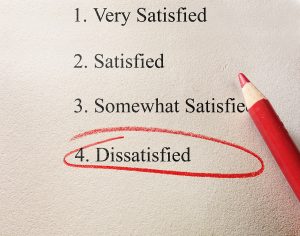The Employee Engagement Survey Says….
The Employee Engagement Survey is likely the biggest FAIL in our efforts to bring people back into workforce activity.
 If you want evidence of this, simply look at the survey numbers. According to the 2016 Gallup Employee Engagement Report, the most any particular industry has risen in employee engagement in four years is only four points. Note that those numbers were pretty low to begin with. So we haven’t exactly made leaps and bounds.
If you want evidence of this, simply look at the survey numbers. According to the 2016 Gallup Employee Engagement Report, the most any particular industry has risen in employee engagement in four years is only four points. Note that those numbers were pretty low to begin with. So we haven’t exactly made leaps and bounds.
Same Song, Different Title
The Annual Employee Engagement Survey is really just a new name for an old system. For years it was called the Annual Employee Satisfaction Survey. It was typically only done at large enterprise organizations. Siemens, Lockheed Martin, and countless others would produce a survey every December. They would then spend so much time compiling the feedback; guaranteeing that the results were dated and no longer valid. At that point they do it all over again.
What’s the old adage about insanity?
Isn’t it doing the same thing over and over again and expecting different results?
The outcome is that the newly named survey gets the same results as it did before.
Think about it. Have you ever really had a company announce a positive initiative based on last month’s employee survey? If you did, it was likely a small company.
Here are some reasons Annual Employee Engagement Surveys don’t work:
-
The word ANNUAL
Determining where your employee engagement stands cannot be successful if only done once a year. It’s hard to be agile when your measurement of progress and direction is so infrequent. What if you conducted a survey quarterly instead of annually? How about monthly?
-
They ask the wrong questions
Typical questions asked on the survey are things like “Are you happy in your work?”, “How do you rate your supervisor?”, “What’s the one thing you would change about your job?”, “Do you think you have a future here?”
The first question is irrelevant because happiness is not your job. An employee can be unhappy and still be engaged. It’s better when they are happy AND engaged, but that’s their choice and not a factor you can affect.
The second question is usually given using a scale of some sort. What makes it useless is that one person’s 7 is another person’s nine or five. Unless very well defined criteria is given, scales aren’t very useful.
The third question is limiting on the one hand and ambiguous on the other. It allows for too many different answers; making it hard to get a consensus and also most answers can’t be implemented. Better to ask about specific initiatives that are already in the works or in place.
The fourth question is not really applicable anymore, particularly with Millennials in the workplace. In general, they can’t imagine a long-term future anywhere, good or bad. With few exceptions, the days of long-term, single-company employment are over. Why ask about it?
-
They ask the wrong people
Most surveys are voluntary; heaven help you if it isn’t. Most of the people who voluntarily take engagement surveys are the ones who are already engaged. The disengaged – the ones you hope to actually learn something about – are not very open to taking a survey, because they don’t believe anything positive will come out of it. Think about ways to directly reach the disengaged – I guarantee you it won’t be through a survey. It requires a personal touch.
-
They are not trusted
We are going to use the results of this survey to improve the work environment.
“Yeah, sure!”You will be totally anonymous on this survey. No one will know what results you submitted.
“Ri-i-i-i-i-i-i-ght!”A whopping 80% of employees, according to one study, do not believe there will actually be a positive outcome to an employee engagement survey.In addition, they don’t believe they will actually remain anonymous and believe they may face repercussions from their responses. Usually, they are right on both counts.
As a trainer, I have asked hundreds of groups to complete course evaluation surveys for me. I read every one of them, usually immediately after the class. I can look through them and identify exactly who completed it based on responses and my memory of their attitude and behavior.
If trust does not exist to begin with, the survey will not improve it; in fact, it will break it down even farther.
-
No real commitment from executive level management
The upper management is willing to put out a survey but not willing to dedicate themselves to taking action. They would rather wait and see what the responses are. From that point they either say “that’s nice” or “what should we do now?” That leads to the last reason.
-
There is no action plan
When there is no commitment there is no plan. For a survey to be effective, you must have a pre-determined plan of how to analyze the responses and act upon the results. Too many times we spend a lot of time and money creating the survey but very little for making it productive for our organization. What good is it to know about a problem if we have no idea what we are going to do about it? It’s money thrown to the wind.
Step up and Boldly Lead
Most organizations are implementing or allowing some sort of social media now. Microsoft Office 365 has a social media feature in it. Many organizations are using SharePoint. It’s possible to create private social media pages for your company or initiative. What if you used that medium for reaching your employees in a more real-time manner?
How about a question of the week? Ask about their opinion on a very specific project or service for employees; no more than 2-3 questions. It’s quick and easy, it’s engaging, and it’s actionable.
Throw the surveys out. Step up and Boldly Lead. Gauge your employee engagement by being more engaging.
[tweetthis]Gauge your employee engagement by being more engaging.[/tweetthis]








